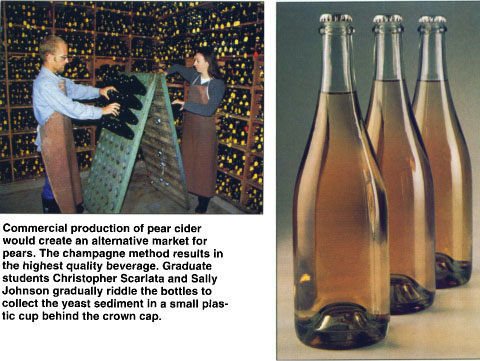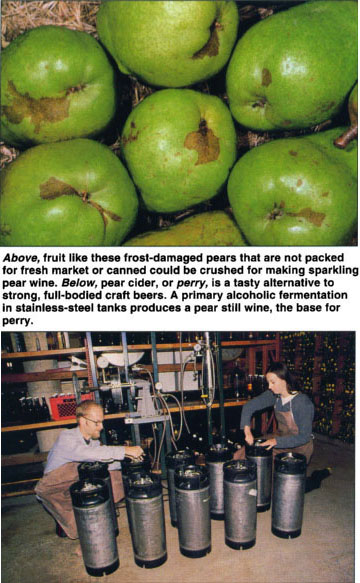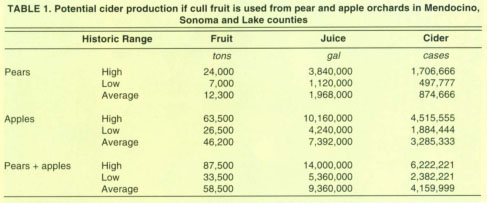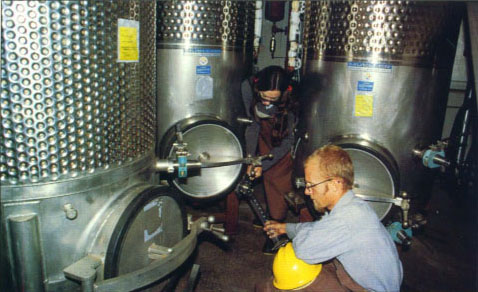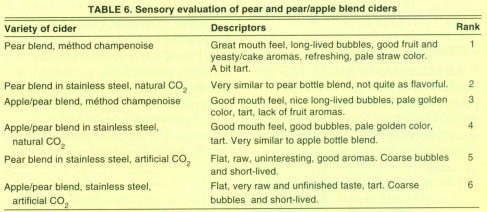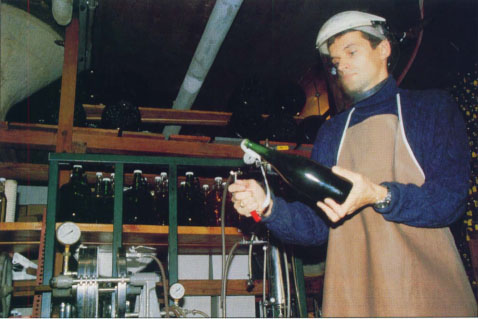All Issues
Feasibility of producing pear wine: Pears produce premium sparkling wine
Publication Information
California Agriculture 52(6):31-36. https://doi.org/10.3733/ca.v052n06p31
Published November 01, 1998
PDF | Citation | Permissions
Abstract
Pear growers and packers continue to need profitable market channels for fruit that is not packed for fresh market or canned. Off-grade fruit that is designated for the juicing market frequently gives growers and packers poor returns unless there are significant shortages of fruit juice concentrates in the marketplace. Finding a use for these fruit in the creation of a higher priced, value-added premium product could greatly strengthen the performance of this segment of the pear market and at the same time use the off-season production capacity of sparkling wineries. Our experiments demonstrate that an ultrapremium-quality cider can be made from juice grade Bartlett pears. Pear fruit should be ripe for optimum flavors and aromas.
Full text
In Northern Europe, a sparkling alcoholic beverage is made from both pears and apples. Cider, or cidre, by definition is fermented juice of apples or pears. These beverages are usually between 4% and 7% alcohol and generally retain some carbon dioxide, so that they have “fizz,” much like beer. The British Isles and Northern France consume large amounts of both apple cider and perry (pear cider). Presently, among consumers 21 to 30 years of age in those countries (the legal drinking age is 16 in most of Europe), cider and perry are the most popular alcoholic beverages after beer. In the last 10 years, Britain has seen a steady consumption of cider, which makes up 10% of the beverages sold in pubs (Berger 1995). Today, the UK cider market exceeds 100 million gallons.
Ciders were widely enjoyed in early American society. Apple trees grew extremely well in New England, and the art of cider making was readily adapted. Because of its availability, cider was inexpensive and was consumed in large quantities. Historical records indicate that per capita consumption of cider in Massachusetts in 1767 was 47.6 gallons. In the 19th century, cider makers began adding rum to cider, making it considerably more intoxicating, resulting in social problems arising from its abuse. Early temperance societies focused on cideries, bringing social pressure for their prohibition. At the same time there was a migration of rural cider-consuming Americans to urban areas, where new immigrants from Europe brought their taste for beer. This competing beverage could be made cheaply from dry ingredients available year-round. This brought about a decline in the consumption of cider in the United States, with Prohibition dealing the industry a death blow in 1919 (Correnty 1995).
Commercial production of pear cider would create an alternative market for pears. The champagne method results in the highest quality beverage, Graduate students Christopher Scarlata and Sally Johnson gradually riddle the bottles to collect the yeast sediment in a small plastic cup behind the crown cap.
Market trends and supply
In the United States there has been a remarkable increase in the consumption of cider over the past decade, growing almost 250% from 1988 to 1994 (Berger 1995). In 1995, 3.7 million gallons of cider were consumed, twice the amount in the previous year. This number doubled again, to more than 8 million gallons in 1997. Although these numbers are impressive, cider remains a small segment (less than 0.2%) of the beverage market compared to beer, at 6.2 billion gallons per year. Interestingly, New England and British Columbia are at the center of the growth of the market for these beverages (Mehta 1996; Fabricant 1997). Progressive growers, such as Alyson's Apple Orchard in Mew Hampshire, have successfully planted various historical European cultivars that may produce visually inferior but highly flavorful fruit for cider production ( www.alysonsorchard.com/fruits.htm ).
Above, fruit like these frost-damaged pears that are not packed for fresh market or canned could be crushed for making sparkling pear wine. Below, pear cider. or perry, is a tasty alternative to strong, full-bodied craft beers. A primary alcoholic fermentation in stainless-steel tanks produces a pear still wine, the base for perry.
A logical market niche for alcoholic ciders is “brew pubs” or micro-breweries that make their own beer, where tart and fruity ciders offer an alternative to strong, full-bodied craft brews. In the British tradition, brew pubs like to offer cider on tap and in bottles. The growth of brew pubs in the United States was phenomenal, from 8 in 1985 to 417 in 1995, but leveling off in 1997. “Craft brews” made by these companies make up about 5% of the total beer sold (Appel 1995). It would be logical for perry and apple cider to be readily offered as companion products through similar marketing channels, either as a bottled product in 12-, 22- and 32-ounce containers or in bulk “keg” containers.
According to a recent study on the feasibility of creating a juicing facility in Mendocino County, in an average year there are 12,300 tons of pears available in the Lake and Mendocino Pear Growing Districts for “other uses” besides canning and fresh market, which includes juicing, drying and freezing. This tonnage is highly variable, ranging from a low of 7,000 tons in 1990 to a high of 24,000 tons in 1987. There is also a significant supply of processing apples in both Mendocino and Sonoma counties, averaging 46,000 tons per year, ranging from a low of 26,500 tons in 1988 to 63,000 tons in 1994. The overall supply of this cull fruit is determined primarily by weather conditions, quality regulations and cull fruit prices (Hardesty 1996). Assuming that a ton of fruit yields 160 gallons of juice, and that a case of cider contains twenty-four 12-ounce bottles (2.25 gallons per case), Mendocino, Sonoma and Lake counties could supply as much as 6 million cases (table 1).
It is very clear that the North Coast Pear and Apple Districts could potentially supply large quantities of juice for a cider industry, on average even more than the current U.S. cider consumption. Another positive point is that the apple acreage in Sonoma County was planted for the processing industry and includes cultivars favored for cider making, such as Gravenstein, Rome Beauty and New Town Pippin.
Fermentation styles
Three fermentation systems are used for commercial cidermaking (Pollard and Beech 1957; Lea 1995, Jarvis et al. 1995; Cabranes et al. 1996; Scott and O'Reilly 1996; Duenas et al. 1997). Choosing a system depends on the volume of fruit to be processed, the size of the market to be served, the quality of the beverage (Mangas 1996) to be delivered and the amount of investment capital available.
The champagne method (méthod champenoise in France) involves making a still wine from pears or apples, then adding yeast, nutrients and sugar for the secondary fermentation (tirage), bottling and capping, and allowing time for the bottles to become carbonated, about 3 weeks. During this time the yeast consumes all of the added sugar, turning it into equal amounts of alcohol and carbon dioxide gas, which provides the natural carbonation. At this point the cider is riddled (remuage), which involves gradually inverting and turning the bottles to collect the yeast sediment in a small plastic cup behind the crown cap, a process of slow movement over several weeks if done by hand. Modern sparkling wineries use automatic riddling machines to achieve the same result within a few days. The cider is then disgorged (dégorgement) by quickly removing the cap to blow out the sediment. For small lots of cider, this can be done by hand. For larger lots it is done by machine, which freezes the bottle neck and disgorges the yeast sediment mechanically. The product is then topped and capped again. If additional sugar, brandy or other flavorings are desired, they are added in the process known as dosage and the bottles are then capped. Small amounts of sulfur dioxide (SO2) are also added to prevent oxidation and to assure microbial stability of the perry.
This process results in the highest quality beverage, but it is expensive to produce. Although the process is highly mechanized in modern sparkling wine houses, it can be done with a minimal amount of equipment for a “boutique” cidery producing 3,000 cases or less per year. Intensive labor replaces machinery.
The traditional method (méthod rurale in France) involves making a still wine from pears or apples, adding yeast and sugar, bottling and capping, and then allowing the cider to carbonate naturally. In the brewing industry, this is known as the “bottle conditioned method” when used to carbonate beer. It requires very careful measurement of yeast and sugar so that “bottle bombs” are not created by overpressurization. The cider is then aged for several months before it is sold. This method, which is widely used by small cideries in Britain and France, results in a high-quality beverage that has a small amount of yeast in the bottom of the bottle. This method involves a minimal amount of equipment and labor, and would be very appropriate for a small “boutique” cidery.
TABLE 1. Potential cider production if cull fruit is used from pear and apple orchards in Mendocino, Sonoma and Lake counties
The charmat method is used to produce carbonated beverages cheaply. There are several variations, but most involve making a still wine from pears or apples and then either artificially carbonating the cider under cool temperatures and pressure with bottled CO2 gas, or adding yeast and sugar, transferring the wine to a pressure tank where the yeast's secondary fermentation naturally carbonates the beverage. The cider is then sterile filtered or chemically preserved and bottled. This method is used mostly for large volumes of beverage that need to be produced at the lowest cost.
Health issues
The Centers for Disease Control and Prevention have recently issued consumer warnings regarding outbreaks of Escherichia coli O157:H7 infections and cryptosporidiosis associated with drinking unpasteurized apple cider (JAMA 1997). E. coli is a bacterium that normally grows in the human gastrointestinal tract, but the pathogenic O157:H7 strain can cause hemolytic uremic syndrome. Apples and pears can become contaminated under unfortunate circumstances by manure from cattle or deer. The survival of E. coli O157:H7 within the complex ecology (Swaffield et al. 1997) of cider fermentation has been investigated (Semanchek and Golden 1996). It was found that cell numbers are reduced to an undetectable level in fermenting cider after 3 days at 68°F (20°C). Although the acidity of fermenting cider is not significantly different from that of nonfermenting cider, the combined effects of pH, SO2, carbon dioxide and ethanol appear to be an effective means of destroying this pathogen without pasteurization.
Nevertheless, we recommend that the production of perry or hard cider should always comply with Good Manufacturing Practices for fresh nonfermenting apple cider, as outlined by the University of New Hampshire Cooperative Extension (Lord and Violette 1997).
1995 Experiments
It was our goal to determine whether Bartlett pears can make an acceptable cider with either the champagne method or the rural method of sparkling wine production, and to compare the sensory properties of ciders made from Bartlett, Bosc and Winter Nelis cultivars.
Bartlett and Winter Nelis pears, about half a ton each, were taken from controlled atmosphere storage and crushed on March 9, 1995. The Winter Nelis fruit was in good condition, but the Bartlett fruit required culling due to some spoilage. The fruit was run through a hammer mill and the juice extracted with a hydraulic press. The juice was then transferred to 160-gallon stainless steel tanks and transported to the winery for fermentation. The Winter Nelis juice was treated with 100 mg/L SO2 to kill spoilage yeast and bacteria. The Bartlett juice was treated with 150 mg/L SO2, because more damage was evident in the fruit before crushing. Bosc fruit was not available, so single concentrate juice was obtained from Naumes Concentrates in Marysville and fermented. No SO2 was added, because the juice was sterilized during the concentrate process. The juices were inoculated with Saccharomyces bayanus yeast (Lalvin EC-1118). The juice was analyzed for soluble solids, acidity and SO2 content (table 2).
The charmat method is an inexpensive way of producing pear cider. The still pear wine is transferred into a small pressure tank where the yeast's secondary fermentation naturally carbonates the perry. To offer cider on tap, it could be shipped in small bulk containers like these.
The winemakers decided, based on their experiences with grape juice fermentations, to adjust the pear juice with the following additions ai the time of yeast inoculation: 3 g/L of tartaric acid to acidify the juice, 100 mg/L diammonium phosphate (yeast nutrient), 50 mg/L pectolytic enzyme to clarify the juice and 2 g/L of tannins. Acidification of the fermenting juice is considered necessary to improve flavor (juices low in acidity taste flat) and to preserve and stabilize the resulting wine or cider. The Bartlett pears were quite ripe when crushed, so the acidity had diminished greatly compared to the Winter Nelis and Bosc fruits, which were relatively firm when crushed. The fruit acids are partly metabolized by the plant during ripening, resulting in a lack of tartness in overripe pears or apples. Tannins were added to give the ciders a more astringent structure and higher complexity in taste.
Fermentation proceeded fairly quickly, and the ciders were ready for bottling and secondary fermentation 10 to 14 days after primary fermentation. At that time the varietal ciders were placed in 750 mL sparkling wine bottles and the following materials were added: 10 g/L sucrose, 100 mg/L diammonium phosphate and 200 mg/L bentonite as a riddling aid. Bottles were then transferred to the cask room of the winery (ambient temperature about 60°F [15°C]), and allowed to go through secondary fermentation. The ciders were sampled following riddling by hand (removing the yeast and bentonite deposits) (table 3).
Sensory evaluation
Samples of the three wines were tasted at the same time by a panel consisting of two winemakers, two vineyard managers and the authors. Ciders were cooled to about 40°F (4°C) for tasting. The following comments and ratings were given.
Bartlett perry.
First place overall, preferred by four of six tasters. Slight oxidation noted, probably due to overripe fruit that was crushed. Very attractive appearance, in the color range of pale yellow to straw. The cider has a pleasant pear fragrance, soft rounded mouth feel and a slight bitterness in the final taste. The cider also tasted a little flat to some of the panel, and they felt that slightly more acidification would improve it. Others found it very refreshing, light and clean tasting.
Bosc perry.
Second place overall. Very pleasant pear fragrance, with a caramel-flavored background. Pleasant but not excessive tartness. Soft rounded mouth feel, more body than the Bartlett cider. Would probably be better if made from fresh juice.
Winter Nelis perry.
Third place overall, but first place for two of the panel. The French members of the panel claimed that this was the closest to the perry that they remembered in France. The cider was well structured and tannic, with almost olive flavors, strong pear fragrance, slightly reduced in odor. Americans found this one the least appealing.
The remainder of the cider was disgorged by machine. Half of the bottles had an additional 7.5 g/L of sugar added to increase sweetness. No additional sugar was added to the other bottles. The cider was cellared again in the winery's cask room and retasted 4 months later. The different ciders held up well, but some refermentation occurred, particularly in the Winter Nelis, to which no preservatives had been added. No agreement was reached among the tasting group as to whether additional sugar improved the flavor of the ciders. Most felt that both the dry and the slightly sweet styles were quite acceptable and refreshing. Some of the Bartlett and Bosc cider had turned a shade of light pink to purple, most likely due to some enzymatic oxidation of phenolic compounds.
1996 Experiments
Based on the positive results from the 1995 vintage, we tried to determine whether secondary fermentation and carbon dioxide priming of still wine in keg containers could produce an acceptable product, and to establish how blending of apple cider and other pear cultivars affects flavor and consumer preference.
Comice, Bosc and Bartlett pears were taken from cold storage, crushed and pressed separately in the same manner as the 1995 vintage and then transferred to 60-gallon plastic food-grade barrels for fermentation. All fruit was firm, green and in excellent condition, requiring minimal sorting and culling. Also crushed was a mix of ‘Jonathan’ and ‘Granny Smith’ apples for the purpose of blending with the different pear juices. The following materials were added to the pear (apple) juices prior to fermentation: 40 (40) mg/L SO2, 3 (0.5) g/L tartaric acid, 50 (50) mg/L pectolytic enzymes, 20 (20) mg/L tannins and 0.2 (0.2) g/L active dried yeast, Saccharomyces cerevisiae (Enoferm ICV D47).
We analyzed the musts before and after the additions (table 4).
The juice was allowed to settle over night, racked the next day and then yeast was added. Fermentation proceeded well and was completed after 4 weeks. The wines were racked and 0.6 g/L bentonite and 20 mg/L SO2 were added to stabilize the finished wines. The still wines were tasted the next week (table 5).
Following the sensory evaluation, the base wines were blended and bottled. Equal parts of Cornice, Bartlett and Bosc were used for an all-pear blend, reasoning that blends tend to increase the complexity of the resulting beverage and compensate for individual deficiencies. An additional blend was made by combining 50% pear wine with 50% apple wine. The following additions were made to the wines: 10 g/L sucrose, 200 mg/L diammonium phosphate and 350 mg/L Adjuvant 85 (riddling aid), and 0.5 g/ L Saccharomyces bayanus (Lalvin EC-1118), with free SO2 adjusted to 25 mg/L. The amended blends were then placed in bottles and capped, or placed in 5-gallon stainless-steel containers (Cornelius vessels used to dispense soft drink syrups). A bottle in each lot was fitted with a pressure gauge to monitor fermentation. Wines were then cellared at 50°F (10°C) and allowed to finish fermentation. Fermentation was completed within 3 weeks, finishing at a pressure of 0.22 MPa. Additional still wines were amended with everything but the yeast, placed in 5-gallon stainless-steel containers and artificially carbonated with compressed CO2 to about 0.2 MPa. Some cider was disgorged by hand for the sensory evaluation (table 6).
We conclude from the tasting that there is some benefit from crushing ripe, soft fruit compared to green, firm fruit. Originally we thought that the green fruit would have enhanced acidity and thus would make a better beverage. Although this assumption may be true for apples, pears have such little acidity that additions of tartaric acid are always advisable to ensure better taste and shelf life. The cider from the previous year was made with much riper fruit, and the aromas and mouth feel were better.
After the first sensory evaluation, the ciders were kept cellared. After 3 months, the wines were resampled and judged to be sound and improved by aging. All were rounder and softer in mouth feel. The ciders overall still seemed acidic, with the apple/pear blend being almost unpleasantly acidic. A subsample of the pear blend cider was deacidified with calcium carbonate. The analysis of the finished ciders is shown in table 7.
Enologist Christian Butzke disgorges the sparkling pear wine by quickly removing the cap to blow out the sediment.
Ultrapremium pear cider
An ultrapremium-quality cider can be made from juice-grade Bartlett pears. Adding other pear cultivars will probably improve complexity and fragrance, because each cultivar seems to have its own unique organoleptic qualities.
Pear fruit needs to be ripe for optimum flavors and aromas. Postharvest ripening similar to preparing fruit for canning would condition the fruit for better juice extraction and fermentation. If fruit is overripe, it is difficult to juice.
There are a variety of ways to make cider. Individual bottle fermentation appears to be the superior method from a quality standpoint. The traditional method, in which yeast residue is left in the bottle, is the easiest to do, requires a minimal amount of equipment and is well suited to small production runs. The champagne method is more involved, but results in an excellent beverage. In addition, bottle aging for about 3 months improved the product. Fermentation in kegs is also relatively easy to do, resulting in a premium-quality beverage. The lowest-quality beverage results from still wine artificially carbonated, but if properly handled it can be a drinkable beverage.
Acidification and SO2 additions result in a stable product that should have a shelf life of several months. Sparkling winemaking technology is very appropriate and well understood.
Application of this project has yet to take place in private industry in California, but we have established the base for immediate implementation.



